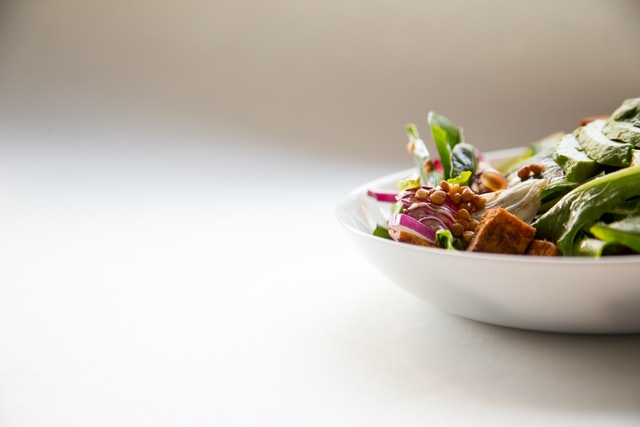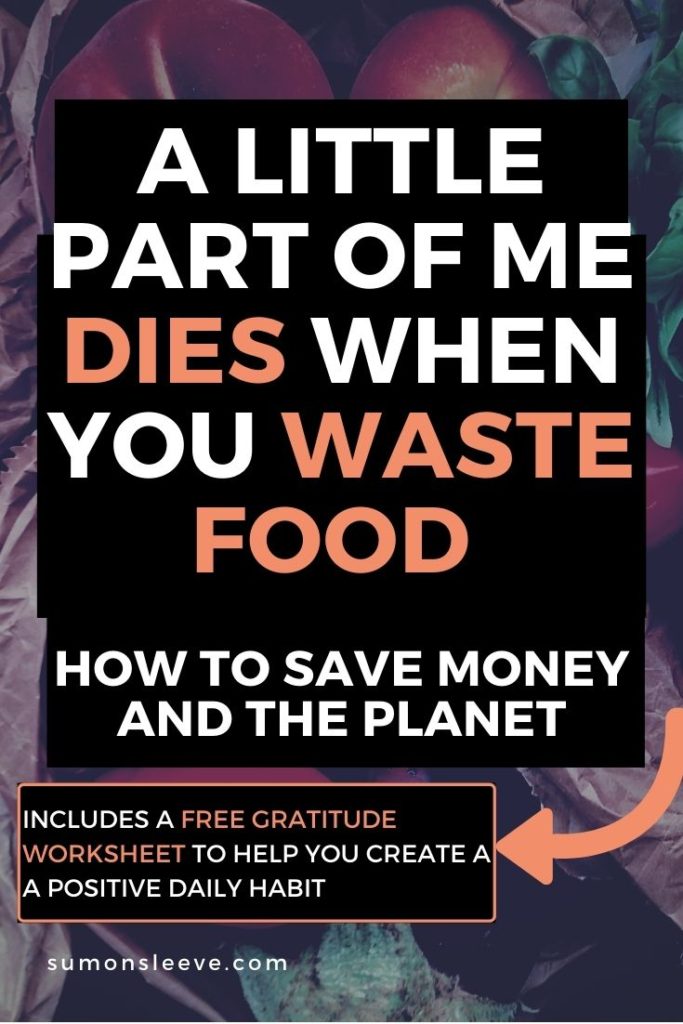Immigrant parents often told their kids to finish their food; however, in this generation, it goes beyond the plate to reduce food waste.

It’s not about finishing your plate.
A couple of months ago, our family went out to dinner for the first time since restaurants opened up. We were excited to finally have some good old greasy fried Canadian potatoes.
For us, it’s always a treat to go out because we eat 90% of our meals at home and I cook like a stereotypical Asian mom; however, this time was a special treat because of COVID. We had been at home for so long that going out to eat felt like our first meal after finishing a prison sentence.
We settle down at our table. The hostess brings us our menus. The adventure begins as we peruse the appetizers, entrees and desserts. I love looking at the kids’ menu because it’s typically good value for the amount of food you get; we impose the parent tax of half a chicken finger for mom and 2 French fries for dad.
Our food comes. I order the clubhouse because I never have the time, patience or all the ingredients to make a sandwich at home. Plus, having someone make a sandwich, deliver it to me while I’m sitting is probably one of the best gifts anyone can give me.
I bite into that triple-decker meat and bread piece of art, savouring the bit of mayo that’s clung onto the corner of my mouth. The smoky bacon, tangy tomato, crispy lettuce, thinly shaved turkey breast, toasted multigrain bread rolls into a ball, lingering on my tongue before I swallow. Between bites, I pluck a fry that’s had a light sprinkle of sea salt and malt vinegar, fully dunking it into ketchup before tossing that into my mouth. The whole experience is incredibly gratifying.
As I’m about to start the second half of my sandwich, I look over at a family sitting two tables away (socially distanced, of course). The dad had also ordered the clubhouse; however, he’s left half his sandwich on the plate, most of his fries and all the crusts of the bread that he did eat. And he’s thrown a napkin onto his plate to indicate to the waiter that he’s finished. The rest of the family didn’t fare any better. Their kids ate most of the fries but barely touched their chicken fingers; the mom left all the tomatoes, olives, beets and onions in her salad.
How is she full from eating lettuce only?
The waiter walks by, takes their plates and comes back with just the bill. The dad pays and the family leaves. I turn to my husband and my eyes are about to pop out of my face and my jaw is dropped, almost unhinged,
Did you see how much food they left on the table?
Can you believe they didn’t take that to-go?
That’s enough for their dinner tomorrow!
When we came home that night, I was still riled up from observing that family throw away all that food. So I started digging deep into myself, doing my own self-reflection exercise and asking myself 5 whys.
Why did I care so much?
Why did the family’s actions pinch my values? What values? What do I believe they went against?
Why was I emotionally triggered?
My “waste not, want not” upbringing
Growing up with Asian immigrant parents, my dad’s paycheque went to 2 things: the mortgage and the groceries. My mom’s paycheque went to our clothes and extracurricular activities. And anything extra went to their savings so they could put an additional payment into the mortgage at the end of the year. Survival was the priority; food and shelter were the main concerns as parents. Money was tight and throwing away food was like throwing away cash. That was their mentality.
My mom was incredibly resourceful in ensuring my 2 sisters and I were fed. Nothing went to waste. That’s how I cook. I still rinse my black bean sauce jars and pour the diluted mixture into whatever I’m cooking. I’ve inherited the Asian mom cooking style which is,
Pinch of this, a handful of that, a few spoonfuls of this and throw in some garlic while you’re at it
Recipe? What recipe?
I was taught to finish my plate which led to emotional eating
My mom would often preach to us that we needed to finish our food, guilt-tripping us with the “starving kids in Africa who have less than us” story. Later on, when we were teenagers, she preyed on our vanity and self-consciousness by coming up with a myth that for every grain of rice we didn’t finish, a freckle would appear on our faces.
Every dinner, she put a lot of thought and effort into her dishes, coming up with exciting flavours and textures with the ingredients she had in her pantry so that it would be enticing enough for her kids to eat. So when she would see food left in our bowls, she’d feel hurt, assuming we didn’t like her food and that we didn’t appreciate her hard work. Food was tied to how she showed her love and despite her good intentions, it manifested into my emotional eating, wanting to finish my plate whenever dinner was served as to not disappoint her.
As I grew up, my emotional eating became disordered eating, trying every diet out there, caffeine pills, laxatives, cleanses, shakes, smoothies and overexercising as a way to expunge the guilt. My recovery began in my late twenties when I was able to tease out my feelings from my hunger cues by practicing mindfulness and finding healthier ways to manage my emotions such as writing, meditation, yoga, talking to friends and family etc.
I want to preserve resourcefulness but eliminate emotional ties
Then when I became a mom, I started seeing the same patterns in myself. I’d get upset whenever there was food left on my kids’ plates, repeating my mom’s assumption that they didn’t appreciate my love for them. I’d bite my tongue, preventing myself from saying something that would guilt-trip them to finish their food.
I’d fight myself, desperately trying not to project my past onto them, to break the cycle so they wouldn’t have a toxic relationship with food. And it was this ongoing battle with myself. I thought I had healed, that I had finally managed my emotional eating but those past experiences resurfaced into my parenting role.
Those conflicting values were being presented when I observed that family throw away their food. It created an opportunity for me to change my mindset around food wastage. I will always feel strongly about it because I value resourcefulness but I can change the reasons why and what I want to do about it.
Redirecting my focus on sustainability and our planet’s future
The context for my values can change by leaning into what I want to believe, not what I was conditioned to believe. I’m no longer a child under my parent’s roof where survival was the mission, where food shouldn’t be wasted because it cost them hours of work to pay for, and where love was shown through providing the basic necessities.
I’m eternally grateful for the time and place that I live in. I am fortunate I am not in my parents’ position, that they took the brunt of the hardship when they immigrated to Canada so that I can thrive and optimize on the opportunities they didn’t have. I want to preserve my parents’ resourcefulness not because I need to survive but because I want my great-grandchildren to survive.
Identifying and appreciating this difference between our generations has allowed me to embrace my past, take action in my present to create a better future for my children. So I started thinking about all the resourceful ways I have lived my life and came up with a list of things I do to reduce wasted food. By sharing my story and tips, I hope to inspire you to redirect your focus away from “finish your plate” to “save our planet.”
Canadian statistics on wasted food
According to the Second Harvest’s 2019 annual report: Feeding People, Not Landfills, more than half the food that is produced gets thrown out in Canada. This is approximately 35.5 million metric tonnes of food every year. And 11.2 million metric tonnes of it can be avoided. From farm to table, here’s the breakdown of this amount:
6% of this is at the farm and producers level
43% of this is at the processors and manufacturers level
5% of this is at the distributors level
12% of this is at the retailers level
13% of this is at the hotels and restaurants level
21% of this is at the household level
Why should we care about wasted food? Why should we do our part in reducing it?
I’m going to state the obvious but it SAVES YOU MONEY! Like my parents, grandparents and great grandparents and ancestors have preached for generations, when you throw out something you bought with money, that is throwing out money.
Next, let’s talk about the earth’s resources that are used to grow food. When you throw out half your burger, do you know how much it took to raise that cow, manufacture that it into ground beef, transport it to a restaurant, grill it and serve it to you piping hot? I’m just talking about the patty. When you leave it on your plate, it takes additional resources to collect, haul and transport to the landfill site.
Lastly, the landfill that keeps growing also keeps producing methane emissions, contributing to the greenhouse gases that continue to heat our planet up.
So I’m going to share with you the things that I do to help reduce wasted food. I’m not someone who gives advice unless I’ve followed it. I’m a realist so these are practical tips that are relatively easy to follow and implement in your life.
Buy what you need
Before going grocery shopping, I always do a quick inventory check to see what we already have in the pantry, fridge and deep freezer. This prevents me from buying something I already have. And most of the time, all I need are vegetables and fruits. That’s it!
I buy enough to make dinners for that week and I only buy produce that is on sale as they are in season. Produce that is in season are often locally sourced and don’t have to travel far to get here. I often have a list and I stick to it. I buy in bulk when there’s a sale but only for the things that I know our family will consume. For instance,
A big sale on boxed mac and cheese or frozen microwavable dinners?
I won’t buy even if it costs pennies a box because it’s not something I enjoy eating nor are they meals I want my family eating. I know it will end up sitting on my shelf and freezer, wasting space until the kids move out.
3kg of ground pork at Costco that costs a fraction of what it is at other stores?
I’m hauling that baby into my cart along with their massive bags of flaxseed, chia seeds, and raisins that I use for baking. Ground pork is like a Chinese staple so it’s one of the essential items I know our family will eat.
Don’t buy food you hope will eat or because you want a good deal.
It’s like someone who buys a bunch of bagged salads because they want to start a diet on Monday but they end up going out to eat every night and by Friday, they have to throw out the wilted, slimy greens in the trash.
Or the person who stocks up on yogurt because it’s heavily discounted that day and didn’t want to miss out on a great deal; however, they don’t even like yogurt and it ends up rotting in the back of their fridge.
Imperfect fruit, “Enjoy Tonight” meats, “Day-old” bread
As mentioned, 12% of wasted food is at the retailer level and this corresponds to about 1.31 million metric tonnes. The waste is created because of a couple of reasons.
Remember back when everyone was stocking up on toilet paper and the shelves were half-empty at the stores? It felt like we were in a zombie apocalypse; we wanted to grab what we needed and get the hell out of there.
Retailers want their shoppers to enjoy their experience because the longer they stay, the more they buy; therefore, they overstock products because they know consumers prefer full shelves. Overstocking leads to expired produce and wasted food.
Another reason is when fruits and vegetables are handled by workers and shoppers, they can easily get bruised and cut; imperfect produce goes unpurchased and ends up in the landfill.
During my grocery shopping trip, I like to do a quick scan of the bread section to see if there are any day-old stuff. It’s usually at least 50% off the regular price and they’ll throw it out if no one buys it. So I’ll grab a bag and when I get home, I’ll freeze that puppy if we already have bread for the week.
Some stores also have meats that are about to reach their “best before” date and will put a sticker that says “Enjoy Tonight” plus a couple of dollars off. Being a foodie family, it gives us an opportunity to try different cuts of meat. So far, we’ve been loving the Italian sausages that are made in-store.
Lastly, I’m a baker and I love using fruit in my loaves and muffins. Stores will sometimes package their too ripe fruit into bags and sell them for a couple of bucks. Often, they are bananas and apples. I’ll peel the bananas, throw them into a ziplock bag and into the freezer. For the apples, I’ll rough cut them, remove the stems and seeds and make apple sauce which can also be frozen.
Store foods properly
I almost always put bread in my freezer because we don’t eat enough of it before it goes stale.
As for fruits and veggies, I don’t wash them until I want to eat them. This is especially true for grapes and berries; once they’ve touched the water, they will spoil very quickly.
Fruits like bananas and apples release ethylene gas that ripens produce nearby so I store them separately.
Don’t lose it, freeze it!
So I’ve talked about my love for my deep freezer. There are so many things you can freeze. From bread, blueberries, yams, ham, chicken carcasses for soups and congee to entire cauliflowers, you can freeze almost everything.
I used to freeze shredded cheese and sprinkle it onto my pasta dishes; however, I realized we go through cheese quickly, well before it starts to go bad.
As mentioned, I like to buy the bags of old fruit and bread and I’ll freeze what we don’t eat.
The latest thing I found out you can freeze is soft boiled eggs. I haven’t tried it yet but it saves time and it’s great when you buy eggs in bulk and don’t know what to do with them. Basically, you boil the eggs, peel the shells, throw them into a bag and freeze. When you want to add them to a noodle soup or Kimchi-jjigae stew, just throw a few into the mix during the last 10 minutes of cooking for them to warm through.
Get creative in the kitchen (learn to cook if you haven’t already)
Slow-cooked dishes, pasta casseroles, rice and beans, stews, soups, congee, one-pot meals are my go-to dinners. They have everything in them, vegetables, starch and protein. When you have stuff that’s about to go bad, this type of cooking will allow you to get creative and resourceful in the kitchen. They are a great way to hide veggies for kids too.
The other day, we had a few cucumbers and some okra in our freezer so I decided to make a last-minute gumbo-inspired stew. I got my massive pot out, ripped open the package of frozen “Enjoy Tonight” Italian sausages, diced some green onions from our garden, opened a can of tomatoes and simmered everything down. Then I microwaved leftover rice and dinner is served.
Cooking is a skill and it takes time and patience to learn but once you reach the level where you can throw something together without thinking, less food gets wasted and meal planning isn’t a headache anymore.
Fill in the gaps with non-perishables
I don’t have teenagers in the house yet but I can already see my kids doing this:
They’re home from school and they throw their crap on the floor, walk into the kitchen and open the fridge. Then they close the fridge and yell,
“Mom, there’s no food.”
And I will roll my eyes,
“Do you know how to use a can opener? Do you know dried fruit is edible? Do you know how to open a jar of peanut butter and toast a piece of bread?
Let me sing to you, child!
Beans, beans, the musical fruit
The more you eat, the more you toot
The more you toot, the better you will feel
So let’s have beans with every meal.”
From baked beans, lentils, kidney beans, chickpeas, black beans, to cannellini beans, these are cheap, nutritious and delicious sources of protein and fibre. Dried or canned, it doesn’t matter how you buy them, they have a long shelf-life and can easily spruce up that pot of soup or stew. I prefer to buy canned beans and dried lentils. The lentils are small and thin enough to cook with rice so I don’t have to remember to soak them the night before.
Other non-perishables that are almost always stocked in my pantry are pasta (we like macaroni because it’s quicker to cook than spaghetti), rice (duh!), canned mushrooms, canned tomatoes and tomato paste, canned tuna, almonds, walnuts, raisins and peanut butter. As for non-perishable Asian foods, I stock up on dried Chinese mushrooms, all types of dried noodles, chicken stock powder, dried fungus, canned baby corn, seaweed, coconut milk, and dried mung bean vermicelli.
When there are no leftovers in the house and the fridge looks empty, I’ll often turn to my pantry and freezer to see what I can whip up for dinner. Most pasta dishes don’t require fresh produce and it’s easy to make a sauce from canned tomatoes, beans and some frozen veggies.
Don’t throw it, re-grow in the garden or compost it
My husband and I started gardening about 4 years ago. I first started regrowing green onions and this piqued my interest.
All I did was cut the ends of the green onions that I bought from the store, put them in a glass with some water, let it grow a bit and then transferred them to our garden. I haven’t bought green onions for years. The next vegetable I want to re-grow is celery. Apparently, it’s the same process.
This year, we grew and harvested our own figs, zucchinis, green beans and snow peas. My husband does the pruning and I’ll water and harvest (and cook of course). Our daughter has been part of the journey. She’s 4 and she helped plant the seeds and water the plants while she plays in the yard. When it was time to eat the fruits of our labour, she understood how much effort it took to grow the vegetables. She appreciated it and really enjoyed the meal.
We throw our brewed coffee grounds into the garden to help with the fertilizer, attracting worms and providing some key nutrients for plant growth. It also helps keep slugs, pests and snails away.
The next things I want to do are to make our own compost so that we rely less on store-bought soil for the garden and to collect rainwater so that we reduce our use of the city’s treated drinking water.
Eat mindfully then mindlessly save the rest
As adults, we need to have an idea of how hungry we are and how much we can eat. Practicing mindfulness during meals is a fantastic way to gauge this and also help manage emotional eating.
When folks scarf down their meals, looking at their phones, shovelling instead of actually chewing, they don’t get to appreciate the ingredients nor are they aware of how much they’ve actually consumed.
Don’t bite off more than you (or your kids) can chew
One of my biggest pet peeves is when someone takes more food than they can eat and throws out their leftovers. This is especially true when there is a gathering of people and the food is self-serve, buffet-style. There’s always one or two people who will take too much; then at the end of the meal, their plate is half full of food with a napkin on top. When the host cleans up, they have no choice but to throw it away because they don’t want to keep someone’s leftovers.
I hate it when parents overestimate how much their kids can eat and then take way too much, assuming they can finish it. Then, when they leave, there’s a mess of half-chewed, saliva covered, soggy crap that no one wants. This behaviour teaches kids to pile their plates when they become adults, that there is a boundless amount of food at their disposal and that there are no consequences when it gets thrown away.
Fuck social expectations around having second helpings
Please, sir, I want some more.
If you know you tend to take more than your stomach can hold, there is no shame in taking a smaller portion first and getting a second helping if you’re still hungry. We’re not in Oliver Twist.
Perhaps those who do this find it socially unacceptable to get seconds or feel the need to leave food on their plate as a sign of respect. Either way, it’s time to break those social expectations and focus on the greater good.





